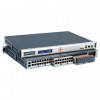Lantronix SLC 8000 Advanced Console Manager User Guide - Page 104
Network > VPN 2 of 2, Enable VPN Tunnel, Only start VPN tunnel in, network fail-over
 |
View all Lantronix SLC 8000 Advanced Console Manager manuals
Add to My Manuals
Save this manual to your list of manuals |
Page 104 highlights
Figure 6-12 Network > VPN (2 of 2) 6: Basic Parameters 2. Enter the following: Enable VPN Tunnel Only start VPN tunnel in network fail-over mode Name Remote Peer Remote Id Select to create a tunnel. Disabling this option will terminate any currently running tunnel. Note: The VPN peer that sends the first packet in tunnel bringup is the initiator or client; the VPN peer that listens for and responds to the first packet is the responder or server. In general, the responder / server side should be started before the initiator / client side. If it is desired to have the console manager VPN tunnel automatically reconnect when the remote peer disconnects and then reconnects, the console manager side of the tunnel should be started first so that it will act as a responder or server. If the console manager side of the tunnel is started after the remote peer, the console manager will act as a initiator / client, and may not automatically reconnect when the remote peer disconnects and is brought back up. Select to start the VPN tunnel only in network fail-over mode. When this option is selected, the VPN tunnel will not start if the network fail-over parameters are not configured, and the network is not in fail-over mode. Whenever there is a network fail-over, the VPN tunnel will automatically start, and when network fail-back happens, the VPN tunnel will automatically go down. If this feature is enabled but the network fail-over parameters are not configured, this setting will be ignored and the VPN tunnel will be started normally and run continuously. By default, this option is disabled. The name assigned to the tunnel. Required to create a tunnel. The IP address or FQDN of the remote host's public network interface. The special value of any can be entered to signify an address to be filled in by automatic keying during negotiation. The console manager will act as a responder/server. How the remote host should be identified for authentication. The Id is used to select the proper credentials for communicating with the remote host. SLC™ 8000 Advanced Console Manager User Guide 104















